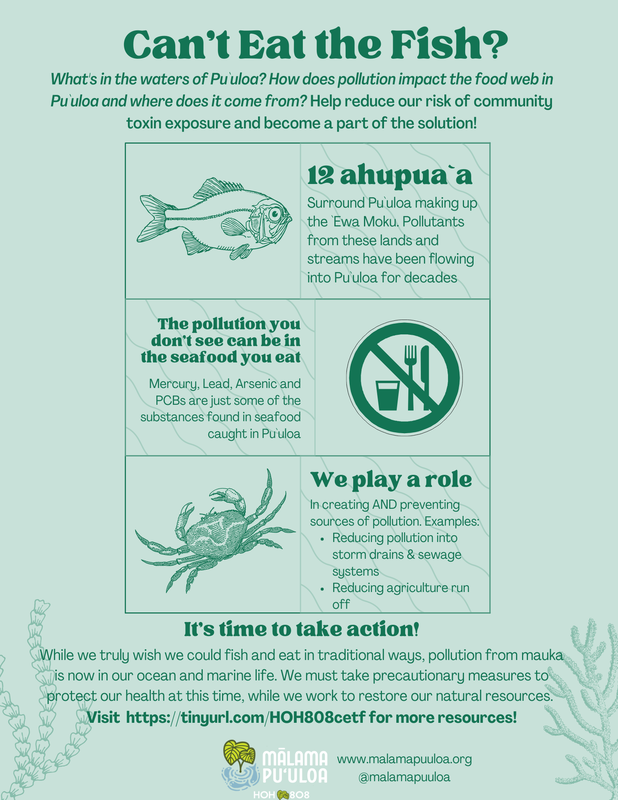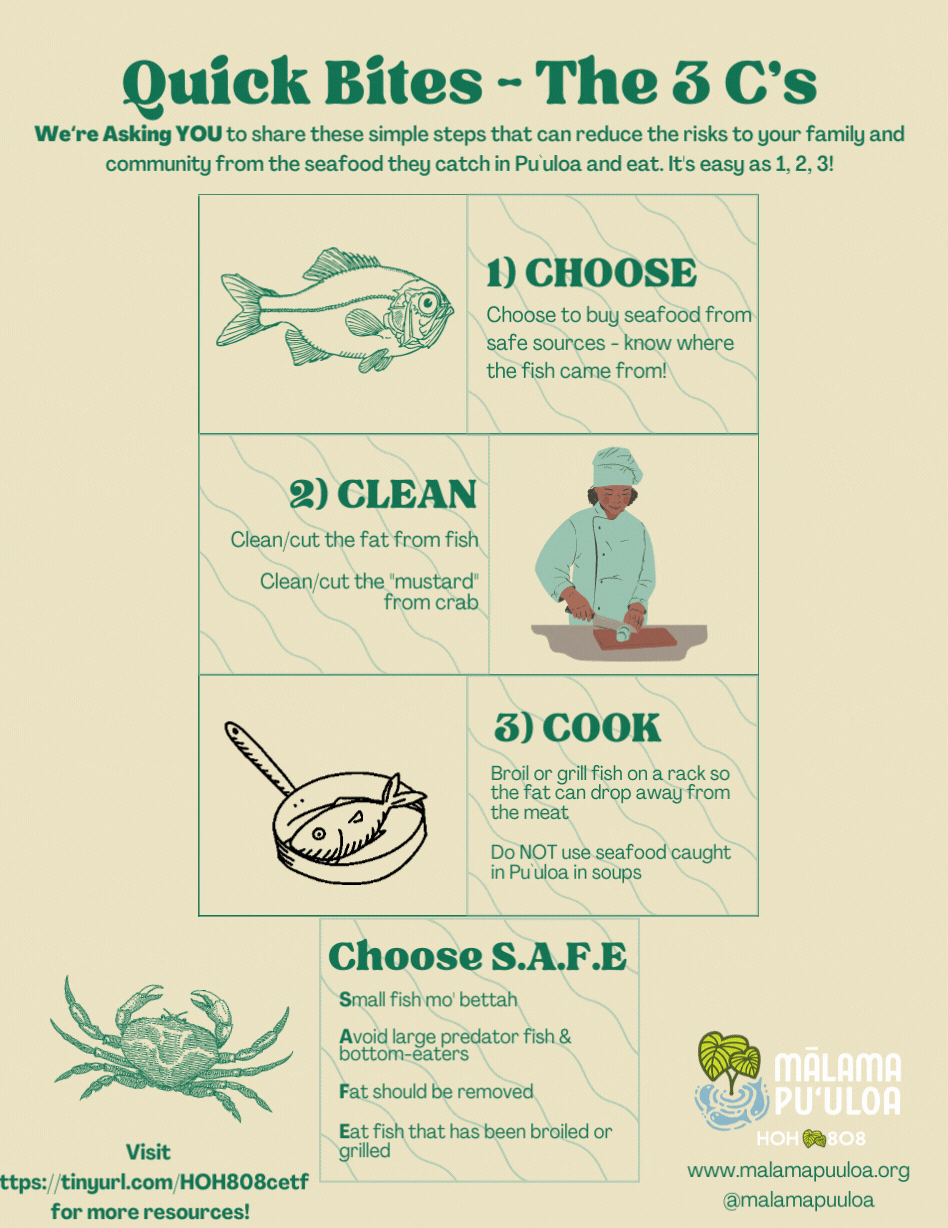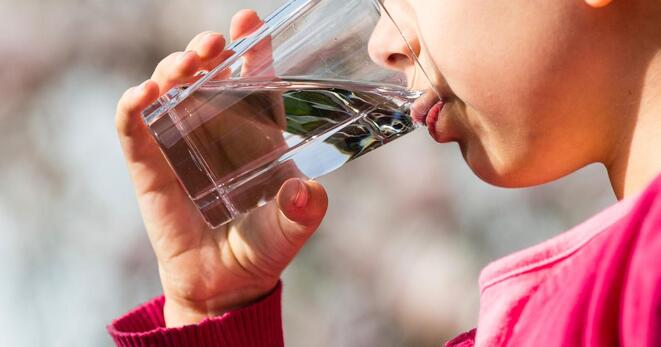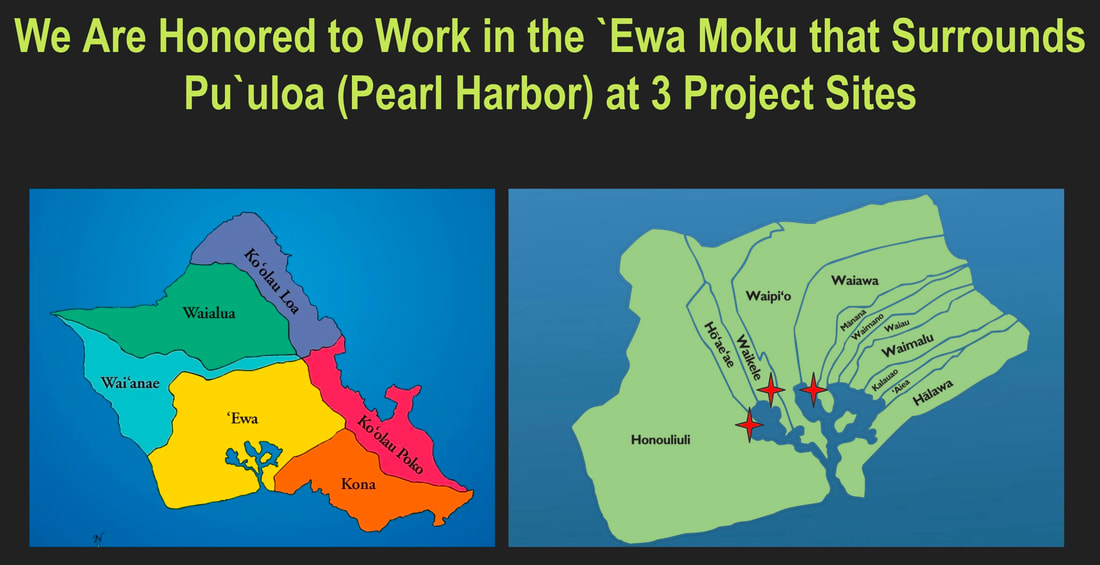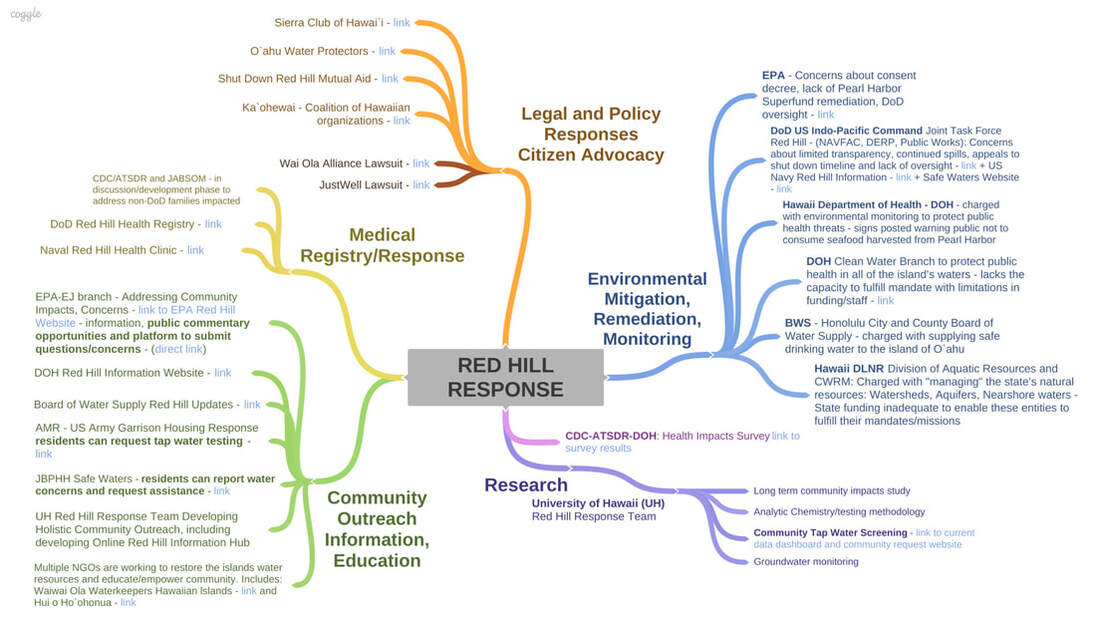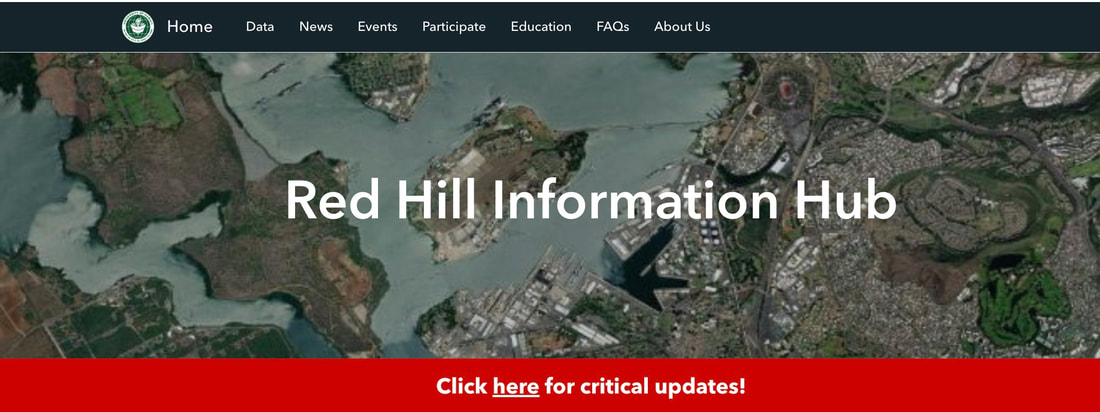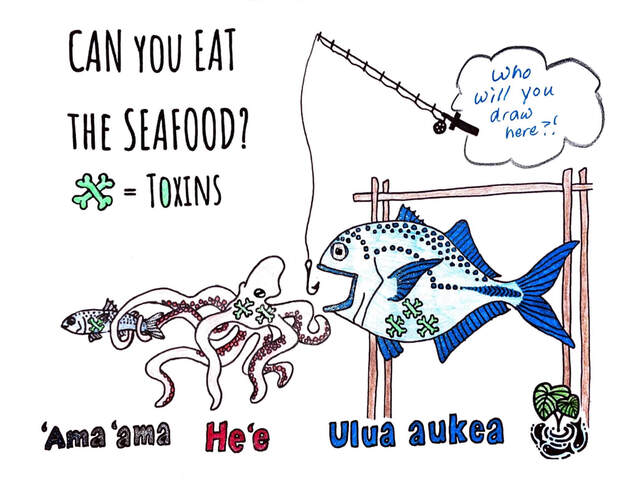Stay Safe! Keep Your `Ohana Safe!
We recommend practicing S.A.F.E. guidelines to protect you and your ʻohana from exposure to toxins from seafood harvested in Pu`uloa!
For More Details on Preparing Crabs Harvested From Pu`uloa
If You Harvest in Pu`uloa Keep Your ʻOhana Safe and Check Out Our New Video!
To those community members concerned about pollution in our drinking water systems, we recommend buying bottled water and/or considering installation of a cost-effective water filter systems on your taps with activated charcoal filters
(and replacing those filters as recommended by manufacturers).
Our Intention
The primary goal of Malama Pu`uloa is to restore Pu`uloa to abundance - ʻāina momona. At one point in time, Pu`uloa was rich with at least 30 loko i`a (traditional Hawaiian fishponds) and acres of loʻi kalo (taro patches). Both the loko iʻa and loʻi kalo were fed by an abundance of estuaries, perennial fresh water springs, shallow aquifers, and the healthy nutrient runoff from 12 ahupua`a.
Over time, Pu`uloa’s aquatic ecosystems have been contaminated with PCBs, dioxins, pesticides, microplastics, lead and more from multiple sources. Many of these toxins persist in the environment for great lengths of time and bioaccumulate in the tissues of fish, aquatic plants, and wildlife, becoming concentrated as they move up the food chain.
We aim to empower the people of `Ewa with information, access and opportunities to gather while restoring the shoreline of Puʻuloa, and contributing to the return of abundant food production to the region. We continually seek to learn more from our community and partners to increase our collective capacity to address pollution that threatens us all.
We believe that this work must be done through a community-driven approach built on trust. In order to heal the land and waters, we must (re)build pilina and come together to do so. Current health and scientific narratives must acknowledge, respect, and compliment indigenous wisdom, place-based knowledge, and cultural practices.
Over time, Pu`uloa’s aquatic ecosystems have been contaminated with PCBs, dioxins, pesticides, microplastics, lead and more from multiple sources. Many of these toxins persist in the environment for great lengths of time and bioaccumulate in the tissues of fish, aquatic plants, and wildlife, becoming concentrated as they move up the food chain.
We aim to empower the people of `Ewa with information, access and opportunities to gather while restoring the shoreline of Puʻuloa, and contributing to the return of abundant food production to the region. We continually seek to learn more from our community and partners to increase our collective capacity to address pollution that threatens us all.
We believe that this work must be done through a community-driven approach built on trust. In order to heal the land and waters, we must (re)build pilina and come together to do so. Current health and scientific narratives must acknowledge, respect, and compliment indigenous wisdom, place-based knowledge, and cultural practices.
Weʻre Working With Others To Develop
Long Term Solutions
We are members of the University of Hawai`i Red Hill Task Force
The University of Hawaiʻi Red Hill Task Force was formed in December 2021 following the confirmation of contamination in drinking water supplied from the Red Hill Shaft. The Task Force is coordinated through the Water Resources Research Center and consists of faculty, staff, and students from UH-Mānoa (UHM) and Leeward Community College (LCC), independent scientists, and trained community volunteers.
Hui o Ho`ohonua is an invited member of this group and participates for the purpose of learning, sharing information with the community, bringing community concerns shared with our organization to the attention of the UH Red Hill Task force, and working to build collaboration that increases the shared capacity to address the challenges of pollution in Pu`uloa.
Members of the UH Red Hill Task Force are developing a comprehensive Red Hill Information Hub that will be shared publicly soon but in the meantime, HOH is sharing an information resource developed by our staff.
Click on the diagram image below to access the interactive version and embedded information links
Hui o Ho`ohonua is an invited member of this group and participates for the purpose of learning, sharing information with the community, bringing community concerns shared with our organization to the attention of the UH Red Hill Task force, and working to build collaboration that increases the shared capacity to address the challenges of pollution in Pu`uloa.
Members of the UH Red Hill Task Force are developing a comprehensive Red Hill Information Hub that will be shared publicly soon but in the meantime, HOH is sharing an information resource developed by our staff.
Click on the diagram image below to access the interactive version and embedded information links
The Red Hill Information Hub Has Launched!
Mahalo nui loa to the hard working members of the UH Red Hill Task Force who developed this resource! There will be more "info hub" launch activities and weʻll post information when they occur. HOH is honored to have played a small role in creating a holistic information hub to keep the public informed about what happened, and what is happening, with Red Hill and the impacts of the associated water contamination that threatens our precious wai.
We Want To Work With Community to Create Solutions
Do you fish in the waters of Pu`uloa? Help us get to know more about community relationships with Pu`uloa.
Free Learning Resources For All
ENVIRONMENTAL JUSTICE THROUGH THE LENS OF COASTAL HEALTH
Dr. Eileen Nalleyʻs presentation video (included below) provides the most updated look at pollution in the nearshore food web of Pu`uloa and how it impacts surrounding communities.
Presented April 14, 2023, as part of the UH Water Resources Research Centerʻs Speakers Series, the presentation is summarized as follows: A legacy of contamination from unsustainable land use affects the health of coastal ecosystems and communities around the globe. In Hawaiʻi and the Pacific Islands, where many communities are reliant on marine resources for their nutrition, livelihood, and cultural practices, contamination poses an acute risk to marine ecosystems and seafood consumers. Using a combination of tools ranging from meta-analysis to toxicology to interviews, we worked in close partnership with resource stewards, community nonprofits, and government agencies to assess the risks posed to the health of marine organisms and consumers and to contextualize these findings throughout the Pacific region. The focus of this work has primarily been on contaminant concentrations in commonly consumed fishes, trophic transfer of contaminants through coastal ecosystems, examining historic land use to assess risk in vulnerable communities, and contextualizing other health threats (e.g., ciguatera poisoning) within the framework of unsustainable land use and resulting habitat degradation. Though most of this work has been based in Hawaiʻi and the Marshall Islands, our findings are relevant for communities throughout the Pacific.
Presented April 14, 2023, as part of the UH Water Resources Research Centerʻs Speakers Series, the presentation is summarized as follows: A legacy of contamination from unsustainable land use affects the health of coastal ecosystems and communities around the globe. In Hawaiʻi and the Pacific Islands, where many communities are reliant on marine resources for their nutrition, livelihood, and cultural practices, contamination poses an acute risk to marine ecosystems and seafood consumers. Using a combination of tools ranging from meta-analysis to toxicology to interviews, we worked in close partnership with resource stewards, community nonprofits, and government agencies to assess the risks posed to the health of marine organisms and consumers and to contextualize these findings throughout the Pacific region. The focus of this work has primarily been on contaminant concentrations in commonly consumed fishes, trophic transfer of contaminants through coastal ecosystems, examining historic land use to assess risk in vulnerable communities, and contextualizing other health threats (e.g., ciguatera poisoning) within the framework of unsustainable land use and resulting habitat degradation. Though most of this work has been based in Hawaiʻi and the Marshall Islands, our findings are relevant for communities throughout the Pacific.
Click on the titles below for free access to materials weʻve developed with a number of partners!
The Watersheds - the Waiwai of `Ewa (Presentation) - It all starts with knowing where our water comes from! This is an introduction to the watersheds of `Ewa and their importance
We Canʻt Eat the Fish? (Presentation) - How can we protect community from toxins in seafood harvested in Pu`uloa?
Ola i ka Wai (Presentation) - A collection of resources created to provide kumu, haumana and the community the opportunity to participate in kūkākūkā (deep, thoughtful discussions and reflection) around the topic of water in Hawai`i.
Fish Safe/Eat Safe (Brochures) - color brochure masters available in 6 local languages
The Kapūkaki (Hawaiian name for Red Hill) Educational Resource Collection - sponsored by Ola i ka Wai and Kanaeokana - note that HOH808 did not contribute to this resource collection but we highly recommend it!
Our new "toxins in the food web" coloring sheet (Single PDF document) - Excellent for use with keiki (and adults who still like to color)...we teach that toxins are "yucky chemicals" that we donʻt want inside of us
We Canʻt Eat the Fish? (Presentation) - How can we protect community from toxins in seafood harvested in Pu`uloa?
Ola i ka Wai (Presentation) - A collection of resources created to provide kumu, haumana and the community the opportunity to participate in kūkākūkā (deep, thoughtful discussions and reflection) around the topic of water in Hawai`i.
Fish Safe/Eat Safe (Brochures) - color brochure masters available in 6 local languages
The Kapūkaki (Hawaiian name for Red Hill) Educational Resource Collection - sponsored by Ola i ka Wai and Kanaeokana - note that HOH808 did not contribute to this resource collection but we highly recommend it!
Our new "toxins in the food web" coloring sheet (Single PDF document) - Excellent for use with keiki (and adults who still like to color)...we teach that toxins are "yucky chemicals" that we donʻt want inside of us

